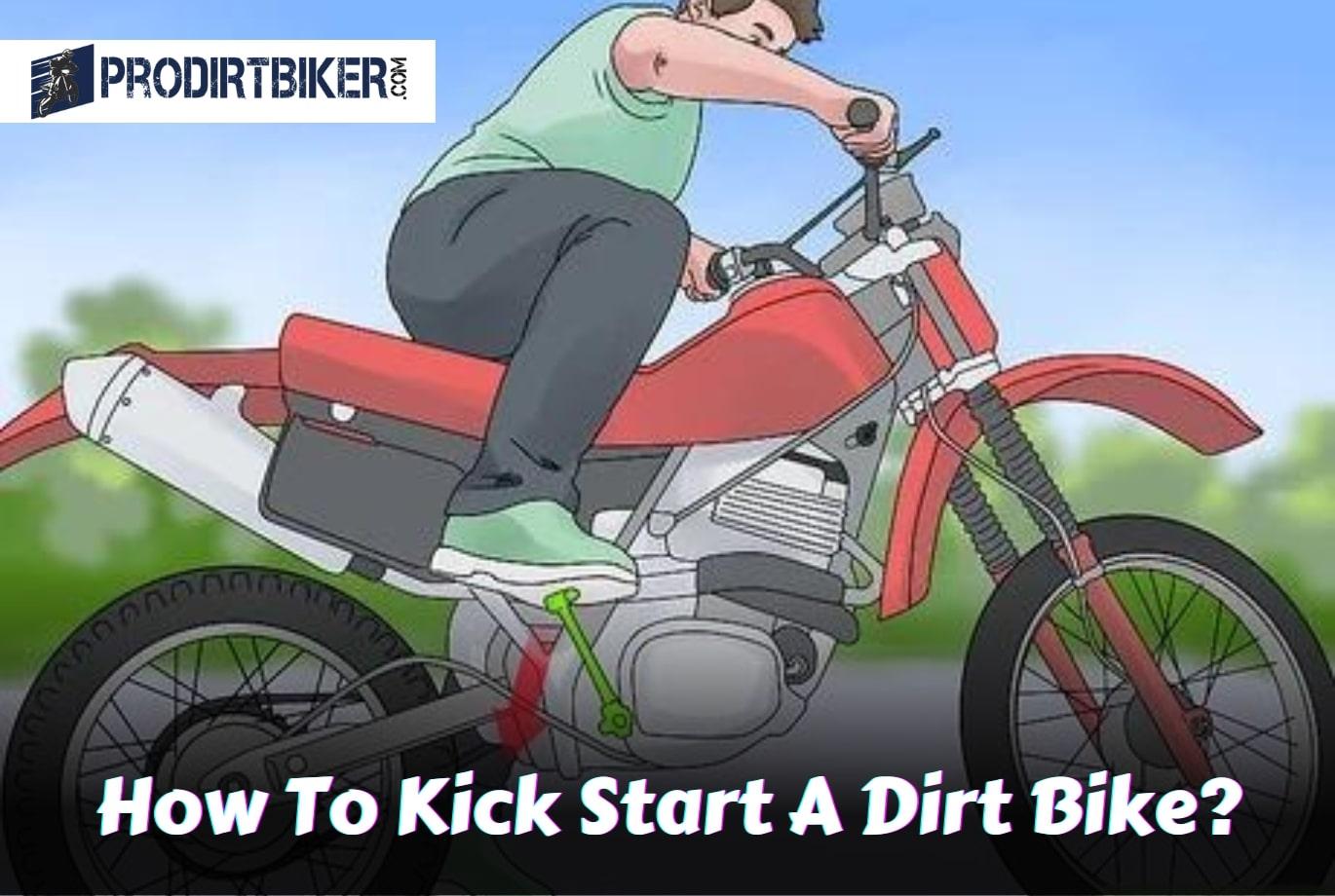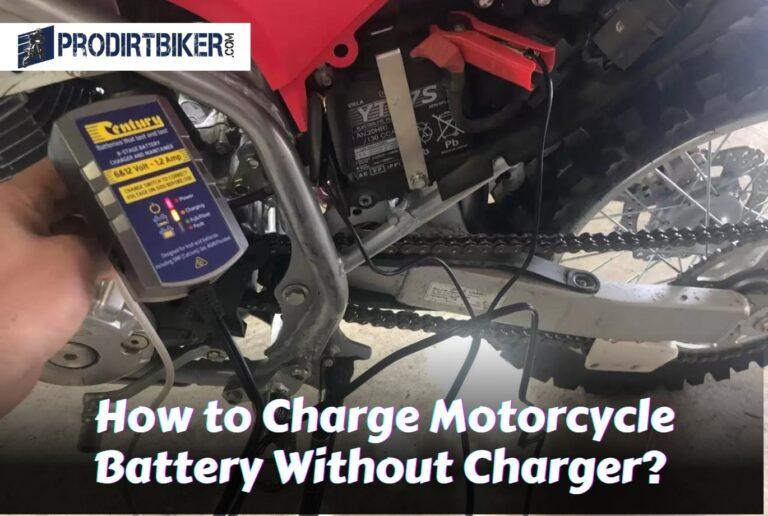How To Kick Start A Dirt Bike? Quick and Easy Tips

To kick start a dirt bike, place your right foot on the kick starter and push down firmly to start the engine. Ensure your left foot is on the ground for stability.
Starting a dirt bike can be an exciting experience, especially for those who are new to the world of motocross. However, kick starting a dirt bike can sometimes be challenging, requiring proper technique and knowledge. We will guide you through the process of kick starting a dirt bike, providing you with the necessary steps to get your engine running smoothly.
Whether you’re a beginner or an experienced rider, these tips will help you kick start your dirt bike with ease. So, let’s dive in and explore how to kick start a dirt bike effectively.
Starting A Dirt Bike: Getting Ready For The Thrill
Gather the necessary gear for dirt biking
Before you kick start a dirt bike and hit the trails, it’s crucial to gather the necessary gear to ensure your safety and enjoyment. Here is a list of essential items you should have:
- Helmet
- Goggles
- Chest protector
- Elbow and knee pads
- Riding boots
- Gloves
- Long pants and sleeves
It’s important to invest in high-quality gear that fits properly and provides adequate protection. Safety should always be your top priority when dirt biking.
Ensure the dirt bike is in good condition
Before starting your dirt bike, it’s essential to perform a thorough inspection to ensure it’s in good working condition. Check the following components:
- Tires: Make sure they are properly inflated and have enough tread.
- Brakes: Test both the front and rear brakes to ensure they are responsive.
- Chain: Check for any signs of wear or damage, and lubricate it if necessary.
- Fluid levels: Ensure that the oil, coolant, and fuel are at the appropriate levels.
- Lights and indicators: Test all the lights and indicators to ensure they are functioning correctly.
Regular maintenance and inspections are crucial to prevent breakdowns and ensure your safety on the trails.
Familiarize yourself with the different parts of the dirt bike
Before kick starting a dirt bike, it’s important to familiarize yourself with the different parts of the bike and their functions. This will help you troubleshoot any issues that may arise and operate the bike effectively. Here are the key components:
| Part | Function |
|---|---|
| Kickstarter | Used to start the engine by kicking it with your foot. |
| Throttle | Controls the speed of the engine. Twist it towards you to accelerate and away from you to decrease speed. |
| Clutch | Engages and disengages the transmission, allowing you to shift gears smoothly. |
| Brakes | Controls the stopping power of the bike. The front brake lever is usually on the right handlebar, and the rear brake pedal is located on the right side of the bike. |
| Shift lever | Used to shift gears. Press it downward with your left foot to shift up and upward to shift down. |
By familiarizing yourself with these essential parts, you’ll be better prepared to kick start your dirt bike and navigate the trails with confidence.
Mastering The Kickstart Technique: Ignite The Engine
Understanding the kickstart lever and its purpose
One of the most crucial components of kickstarting a dirt bike is understanding the kickstart lever and its purpose. The kickstart lever, also known as the kick starter, is a lever found on the side of the engine that allows riders to manually start the bike by using their foot to push it downward. It is connected to the engine’s crankshaft, which is responsible for igniting the fuel mixture and getting the engine running. The kickstart lever helps generate the necessary force to turn the engine over and initiate the combustion process. It’s essential to understand the kickstart lever’s functionality and how to utilize it effectively to ignite the engine.Proper positioning and posture for kickstarting
To kickstart a dirt bike successfully, proper positioning and posture play a vital role. Here’s a guide to achieving the correct position and posture for kickstarting: – Stand on the left side of the bike with the kickstart lever within easy reach of your right foot. – Keep your body weight centered and balanced over the bike to maintain stability throughout the kickstart process. – Position your right foot on the kickstart lever, ensuring it rests securely and comfortably on the lever. – Align your body, focusing on maintaining an upright posture with a slight bend in your knees. – Place your left foot onto the footpeg for support and stability during the kickstart motion. – Keep your upper body slightly forward and engage your core muscles to provide added stability and strength during the kick. By adopting the correct positioning and maintaining good posture, you’ll optimize your chances of executing the kickstart technique effectively.Executing the kickstart technique effectively
To kickstart a dirt bike effectively, follow these steps: 1. Ensure the bike is in neutral: Before attempting to kickstart the bike, make sure the bike is in neutral to prevent any accidental movement. The neutral gear can usually be identified by a green light on the bike’s dashboard. 2. Prime the engine: If the bike has a choke or fuel valve, make sure it is in the correct position for starting. Refer to the bike’s user manual for specific instructions on using the choke or fuel valve. 3. Engage the kickstart lever: With your right foot positioned securely on the kickstart lever, use a smooth and controlled motion to press the lever downward. Apply a firm and steady force, avoiding any sudden or jerky movements. 4. Follow through with the kick: After pressing the kickstart lever downward, allow it to return to its original position. This helps reset the lever for the next kick. If the engine does not start on the first kick, repeat the process by engaging the kickstart lever again.Troubleshooting common kickstart issues
Occasionally, kickstarting a dirt bike may pose some challenges. Here are a few common kickstart issues and troubleshooting tips: – Lack of compression: If the kickstart lever feels loose or lacks resistance, it may indicate a compression problem. Check the bike’s compression level and consult a mechanic if necessary. – Difficulty finding the top dead center (TDC): The TDC is the point at which the kickstart lever can generate the most force to ignite the engine. If you’re having trouble finding the TDC, try slowly turning the engine using the kickstart lever until you feel resistance, then move the lever slightly back before attempting the kick. – Ignition or fuel issues: If the bike still won’t start after multiple attempts, it could be due to ignition or fuel-related problems. Check the spark plug, fuel lines, and carburetor for any issues and ensure they are functioning correctly. – Seek professional assistance: If you’re unsure about any kickstart issues or troubleshooting tips, it’s always best to consult a professional mechanic who specializes in dirt bikes. They can identify and resolve any underlying problems with the kickstart system. By understanding the kickstart lever and its purpose, adopting proper positioning and posture, executing the kickstart technique effectively, and troubleshooting common kickstart issues, you’ll be well-equipped to master the art of kickstarting a dirt bike. With practice and patience, you’ll soon be igniting the engine with confidence and hitting the trails in no time!Utilizing The Choke: Maximizing Starting Success
Welcome to our guide on kick-starting a dirt bike! In this section, we will be focusing on the role of the choke in starting a dirt bike, how to effectively use it, determining when to use it, and some tips for using the choke during different weather conditions. One key component in achieving starting success is properly utilizing the choke. Let’s dive in!
Explaining the role of the choke in starting a dirt bike
The choke plays a crucial role in starting a dirt bike. It is designed to restrict the airflow into the carburetor, thereby enriching the air-fuel mixture for easier combustion. When the engine is cold, a richer mixture is required to ensure smooth starting. By utilizing the choke, you increase the fuel flow and create a more optimal ratio for ignition.
How to effectively use the choke on a dirt bike
To effectively use the choke on a dirt bike, follow these steps:
- Locate the choke lever or knob on your dirt bike. It is usually positioned near the carburetor or on the handlebars.
- If the engine is cold, fully engage the choke by pulling the lever or turning the knob to the “on” position.
- Once the choke is engaged, proceed to start the dirt bike by using the kickstarter or electric starter, depending on your bike’s configuration.
- Once the engine has started, gradually release the choke. Start by moving the lever or knob halfway towards the “off” position.
- Allow the engine to warm up for a few minutes, then fully return the choke lever or knob to the “off” position.
Determining when to use the choke for starting
Knowing when to use the choke for starting is essential. As a general guideline, if the engine is cold, especially during colder weather conditions, it is recommended to use the choke. Cold temperatures make it harder for the engine to start, and the choke assists in providing the necessary fuel enrichment. On the other hand, if the engine is already warm, using the choke may flood the engine with excessive fuel, making it difficult to start. In such cases, the choke should be left in the “off” position.
Tips for using the choke during different weather conditions
To optimize your starting success, here are some tips for using the choke during different weather conditions:
| Weather Condition | Choke Usage |
|---|---|
| Colder temperatures | Engage the choke fully for cold starts. Gradually release it as the engine warms up. |
| Hot temperatures | Use the choke sparingly or leave it in the “off” position. Excessive fuel enrichment may flood the engine. |
| Humid conditions | Consider using a slightly higher choke setting to compensate for the increased moisture in the air. |
By adjusting the choke according to the weather conditions, you can ensure optimal starting success and prevent potential flooding or stalling.
Remember, mastering the art of utilizing the choke is crucial for kick-starting your dirt bike with ease. Understanding its role, effectively using it, determining when to use it, and considering different weather conditions will greatly improve your chances of starting success. Now that you have a solid grasp on utilizing the choke, you’re one step closer to enjoying thrilling rides on your dirt bike! Stay tuned for the next section on troubleshooting common starting issues.

Credit: whyinstitute.com
Bump Starting: Your Backup Plan
Understanding the concept of bump starting a dirt bike
Before we dive into executing the bump start technique, it’s important to understand the concept behind it. Bump starting, also known as roll starting or pop starting, is a backup method to start your dirt bike when the kickstarter or electric start fails to work. It involves using the bike’s momentum to engage the engine and get it running. This technique can be a lifesaver in situations where you’re stranded and need to get your bike up and running quickly.
Executing the bump start technique safely and effectively
To safely and effectively perform a bump start, follow these steps:
- Find a suitable downhill slope or recruit a friend to help push the bike.
- Ensure the ignition is turned on, the bike is in gear, and the clutch is fully engaged.
- Hold the clutch lever in and keep the bike balanced.
- Start running alongside the bike while keeping your weight forward.
- Release the clutch lever quickly and smoothly to engage the engine.
- If done correctly, the engine should start, and you can continue riding.
Remember, safety is paramount when bump starting a dirt bike. Always wear protective gear and ensure the area is clear of any obstacles or hazards.
Factors to consider when deciding to bump start a dirt bike
While bump starting can be a useful technique, it’s important to consider certain factors before attempting it:
- Bike condition: Ensure your bike is in good working condition, particularly the clutch, transmission, and ignition system.
- Terrain: Choose a suitable terrain that allows for smooth rolling and enough space to gain momentum.
- Safety: Assess the safety of the area, ensuring there are no hazards or oncoming traffic.
- Physical ability: Bump starting requires some physical exertion, so make sure you’re up for the task.
By considering these factors, you can make an informed decision on whether bump starting is the right option for your specific situation.
Transitioning from bump starting to kickstarting
While bump starting can be a handy backup plan, it’s essential to address the underlying issue causing the kickstarter or electric start to fail. Once you have successfully bump started your dirt bike, take the time to diagnose and fix the problem.
If you’re unfamiliar with fixing mechanical issues, it’s recommended to seek professional help or consult your bike’s manual to troubleshoot the problem. Transitioning from bump starting back to kickstarting ensures a reliable and efficient starting method for your dirt bike in the long run.
Frequently Asked Questions On How To Kick Start A Dirt Bike
How Do You Kickstart A Dirt Bike Easy?
To kickstart a dirt bike easily: 1. Place your left foot on the ground and your right foot on the kickstarter pedal. 2. Push down firmly on the kickstarter pedal to start the engine. 3. Make sure the engine feels tight before backing off the kickstarter.
4. Avoid jumping on the kickstarter pedal and pull the valve on while kicking. 5. Follow proper maintenance guidelines to ensure easy kickstarting.
Do You Hold The Clutch When Kickstarting?
No, you do not hold the clutch when kick starting a dirt bike.
How Does A Kickstarter Work On A Dirt Bike?
A kickstarter on a dirt bike works by using a lever to engage a gear linked to the crankshaft. This gear causes the crankshaft to spin past top dead center, allowing the ignition spark to ignite the fuel mixture. After starting, the lever is folded back.
How Do You Start A Dead Dirt Bike?
To start a dead dirt bike, follow these steps: 1. Make sure the fuel valve is on. 2. Use the kickstarter, pushing down hard to start the engine. 3. Keep your left foot on the ground while applying pressure to the pedal with your right foot.
4. Cycle the engine until it feels “tight,” then release the kicker. 5. Repeat the process if necessary.
How Do You Kickstart A Dirt Bike?
To kickstart a dirt bike, simply hold the handlebars, stand on the footpegs, and push the kickstarter lever down forcefully with your foot.
Conclusion
Starting a dirt bike can be an exhilarating experience, but it’s important to know how to do it right. By following the proper techniques, such as using the kickstarter and understanding how to troubleshoot any issues, you can ensure a smooth start every time.
Remember to pay attention to factors like the choke and compression stroke as well. With these tips in mind, you’ll be ready to kick start your dirt bike with confidence and enjoyment. Happy riding!



